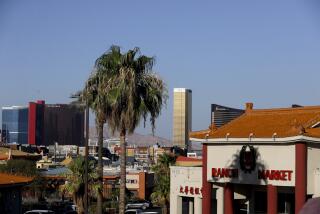100th Birthday : Simi Gets Many Happy Returns of Bygone Days
- Share via
Simi Valley, a city of tract homes and industrial parks surrounded by rock-studded hillsides, was described 100 years ago as “the very garden of the state” by a group of investors trying to sell parts of it to Midwestern farmers and doctors.
The Midwesterners were also told in a 16-page prospectus that Simi Valley had “the most perfect climate on the continent,” complete with a river wide enough to float a paddle boat. A scout sent to inspect the land reported that the river seemed to be missing, but the Midwesterners bought ranches and founded “Simiopolis” in 1888 anyway.
On Saturday, members of some of those pioneer families joined about 100 others to celebrate Simi Valley’s centennial in a setting reminiscent of the community’s early days. The party was held at Robert P. Strathearn Park, a 6.2-acre parcel that contains several historic buildings, including the city’s oldest home, and is dotted with antique farm machinery and fruit trees.
Elaine Willard Cannell, 81, a native of Simi Valley who has moved to Mariposa, Calif., had no trouble Saturday remembering the names of members of her high school graduating class.
“There were only five of us in the class of 1925,” Cannell said. “My dad knew the name of every woman, child and dog in Ventura County.”
Simi Valley now has a population of about 100,000. Houses have replaced cattle ranches and citrus and walnut farms, and the big screen of the drive-in movie theater looms over the old Strathearn Ranch where Saturday’s party was held.
The city has changed so much in the past 30 years that Grant Appleton, 51, who moved away in 1958, said he “barely recognized a thing” during a drive around town Saturday.
“You used to be able to drive along Los Angeles Avenue without seeing a single car,” Appleton said. A descendant of a pioneer family and a real estate agent, he recently moved to Camarillo from Oregon.
Start of a Suburb
Simi Valley began turning into a bedroom community of Los Angeles in the late 1950s after farmers depleted the once-abundant ground water and began selling their land to developers, city historian Pat Havens said. It’s a period of the city’s history that she said she would rather not dwell on, a time when Simi Valley residents, attracted by down payments of as little as $1 for inexpensive housing, were so poor they were not trusted to cash checks in the San Fernando Valley.
Today, Simi Valley has managed to become one of Ventura County’s most stable middle-income cities, in part because of the rise in land values and its ability to attract light industry such as computer plants. And even before the city was incorporated in 1969, a group of residents formed a society to preserve its history.
The society got a boost in 1969, when the Strathearns, members of the Scottish family that bought a huge ranch in Simi Valley in the early 1890s, donated their house and property for the park. Part of the house was built of 3-foot-thick adobe bricks shortly after the Spanish granted Rancho Simi to Santiago Pico in 1795. It is the city’s oldest remaining structure.
Simi Valley got its name from the Spanish, who called it after the Chumash Indian term for the area, “Shimiji,” Havens said. She added that although the exact meaning of the word is unknown, it has something to do with wind and clouds.
The Midwestern pioneers shortened “Simiopolis” to Simi 6 months after they arrived, she said.
Contrary to popular usage, “Simi” should be pronounced with the accent on the second syllable because that is the way the Spanish pronounced it, she said.
Also in Strathearn Park is one of 12 prefabricated houses shipped to Simi Valley by Midwestern pioneers in the late 1880s. An unpretentious 2-story, wood-frame house that Havens says “wants to be Victorian,” it is open to visitors who seek a glimpse of what life was like when wood stoves and butter churns were the norm.
But the good old days when Simi Valley was a rural community really weren’t so good, said Jim Runkle, 81, a native of the city and a former cattle rancher.
“They talk about the good old days, but when you had to get up at 4 a.m. to work, have breakfast at 6 a.m., and then work until 7 p.m., the most you can say about those days is that they were damn long ones,” Runkle said.
More to Read
Sign up for Essential California
The most important California stories and recommendations in your inbox every morning.
You may occasionally receive promotional content from the Los Angeles Times.










